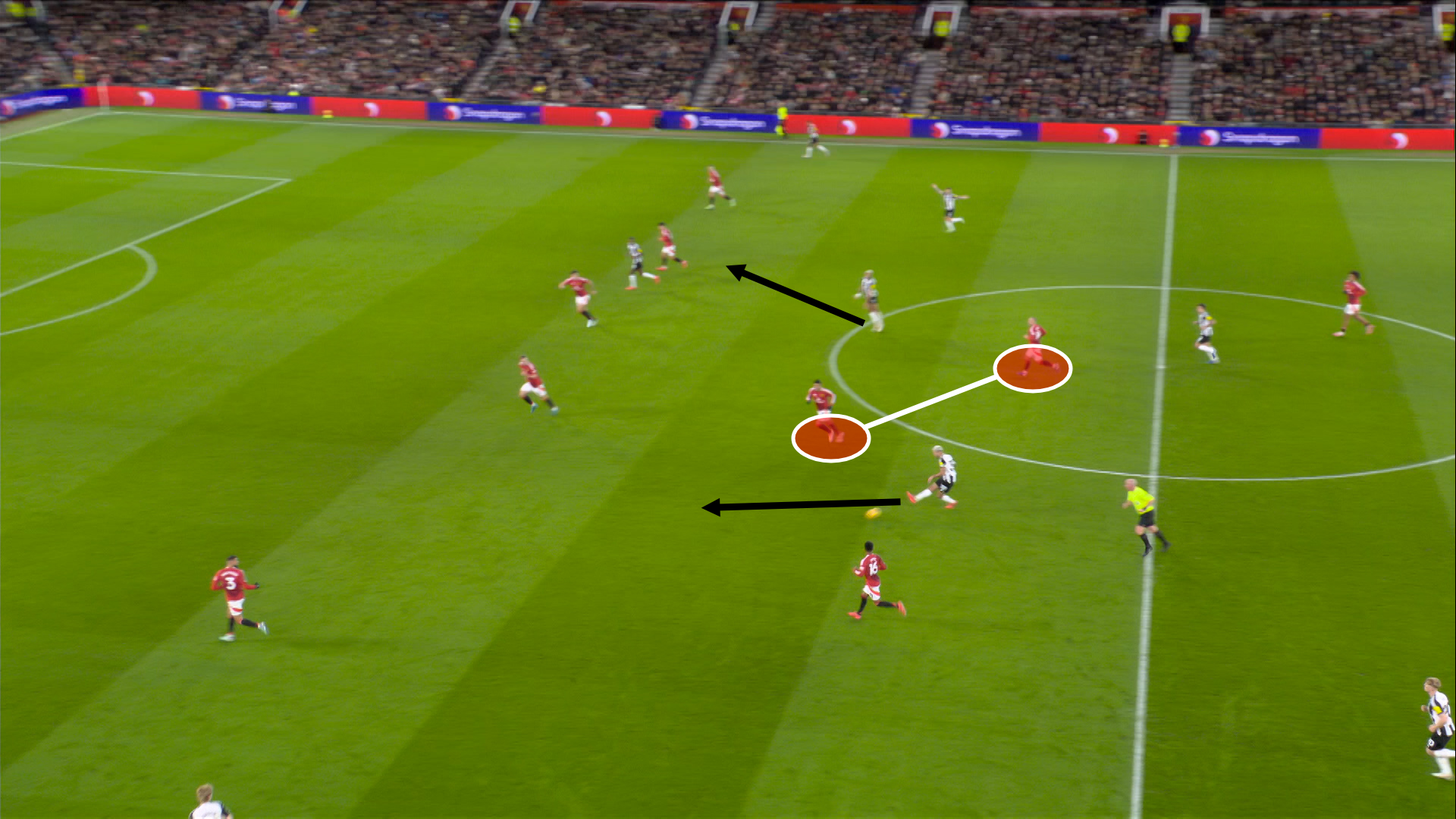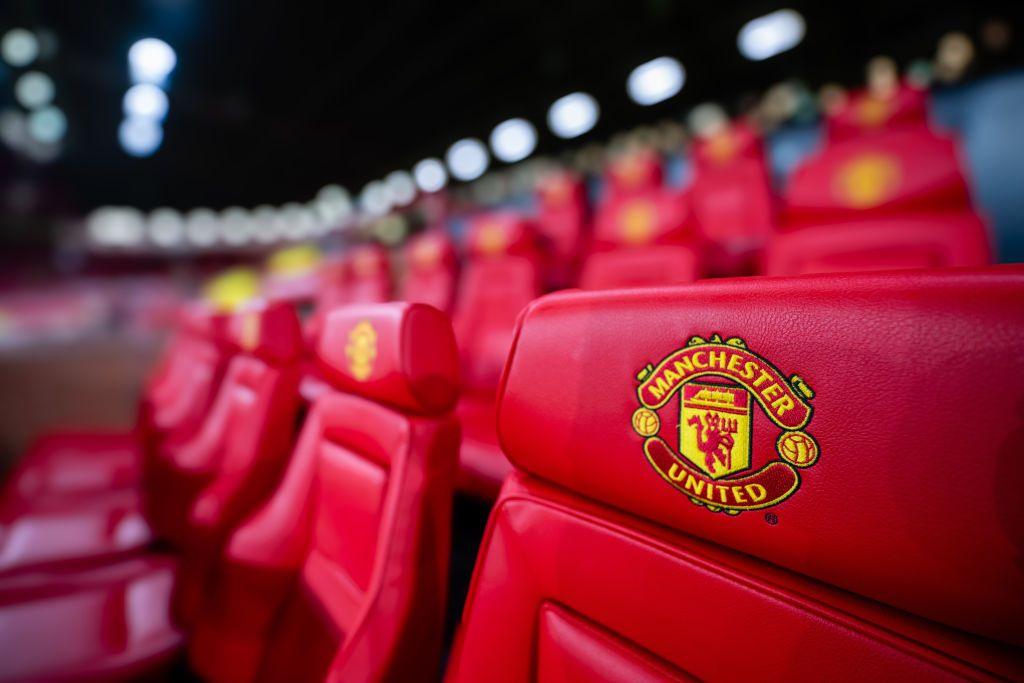How Amorim's tactics gave Man Utd hope after the 'storm'

- Published
When Ruben Amorim predicted a "storm would come" surely even he did not anticipate the scale of the tempest through December.
Six defeats from 11 games was the worst start by any Manchester United manager since 1932.
But hope has arrived in the most unlikely of places - United's spirited draw at Anfield was more together, more coherent and more Amorim than any other performance under the new leadership.
It is too early to say whether the storm has passed or whether they are simply in its eye - the clarity this week a temporary illusion before United are swept up again.
Either way, the Red Devils now have a template to follow. And not before time.
BBC Sport explores what has changed - and, more pertinently, what has not changed - since the Portuguese manager first arrived at Old Trafford on 11 November.
Tactical plans faltering without time to train
Amorim has managed nine Premier League matches, the same number as Erik ten Hag this season, making the pause for FA Cup third-round weekend - and an eye-catching tie away to Arsenal on Sunday - the perfect moment to assess how the new boss is doing.
And the headline numbers are not good.
Amorim has won eight points, compared to Ten Hag's 11, and although United's possession average has risen slightly (from 53% to 55%) they are worse at both ends.
This passes the eye test.
Manchester United have looked a little dazed and confused in the new 3-4-3 formation, at least partly because they are struggling to press effectively, creating decompressed lines and giving the appearance of a wide-open team drifting through matches.
Comparing the two nine-game periods, United's high turnovers have dropped from 83 to 56, their pressed sequences are down from 128 to 100, and their total distance run is down from 976.2km to 966.5 km.
This could be because they don't have the right players for Amorim's high-energy pressing and possession football, or it could be because there simply hasn't been the training time for Amorim to build fitness and etch patterns of play into muscle memory.
Defence: Chopping & changing has created disjointed back three
There is a third reason that is less discussed.
Up to and including the 3-0 defeat by Bournemouth on December 22, Amorim changed the back three, the midfield pair, the wing-back pair and the inside forward pair between every single Premier League match.
When there is no time to train, efforts should be made for matches to mimic lab conditions, yet the United players have rarely been given the chance to discover rhythms or forge relationships. Until now.
United's average number of changes has dropped from four per game to three since the Bournemouth defeat, while at Anfield they lined up with the same back five as the previous Premier League outing for the very first time under Amorim.
The gaps between Matthijs de Ligt, Harry Maguire and Lisandro Martinez were reduced and United's ability to defend crosses - a major concern over the past couple of months - notably improved.
Nine of the 16 Premier League goals United have conceded under Amorim (56%) have been from crosses, yet at Anfield Liverpool failed to complete a single open-play cross into the area (from 17 attempts) for only the second time this season.
Consistent team selections are surely the way forward.
'Some signs of life at Man Utd - now there can be no more excuses'
- Published5 January
Midfield: Amorim's two-man centre has looked light
That need for stability is as true for central midfield as it is for defence, because the performance at Liverpool was predominantly defined by the energy and tenacity of Manuel Ugarte and Kobbie Mainoo, who surely now deserve a run in the team.
The main issue with Amorim's 3-4-3 has been the spaces that open either side of the two-man midfield, especially when the wing-backs are forced to drop to form a 5-2-3 shape.
This peaked in the 2-0 defeat by Newcastle, when Joelinton and Bruno Guimaraes dominated in those gaps, leading directly to the two goals.
- Image source, Premier League
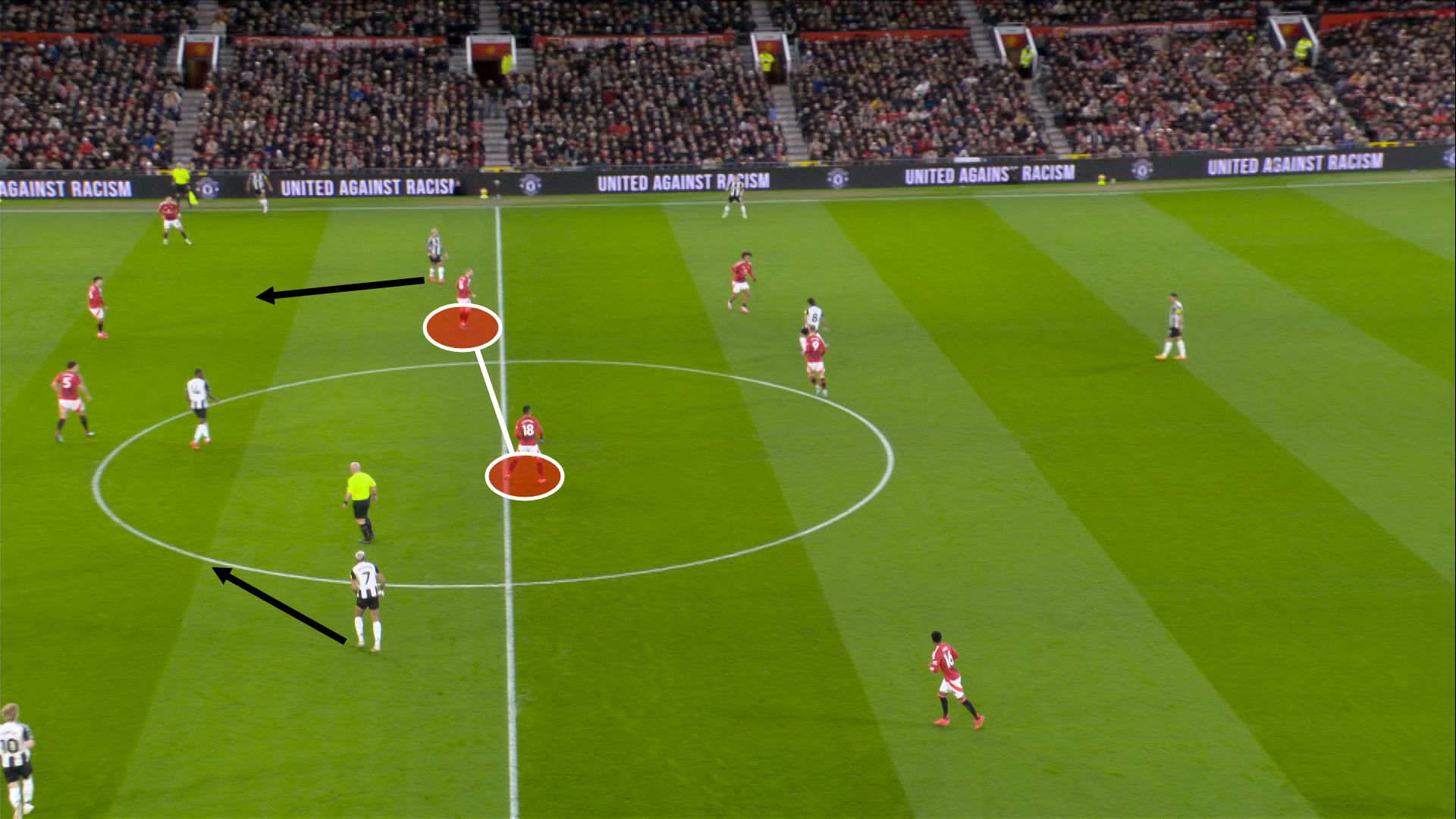
Image caption, Newcastle's midfield duo were able to exploit the space in front of Manchester United's back four in the build-up to Alexander Isak's fourth-minute header
1 of 2
It followed a consistent pattern over the past two months, hence why United's numbers are down across key metrics that indicate a passive or easy-to-play-through midfield.
At Anfield, however, Mainoo and Ugarte did brilliantly to shuttle across the width of the pitch.
They were also helped by the wing-backs aggressively stepping up and Bruno Fernandes dropping into midfield.
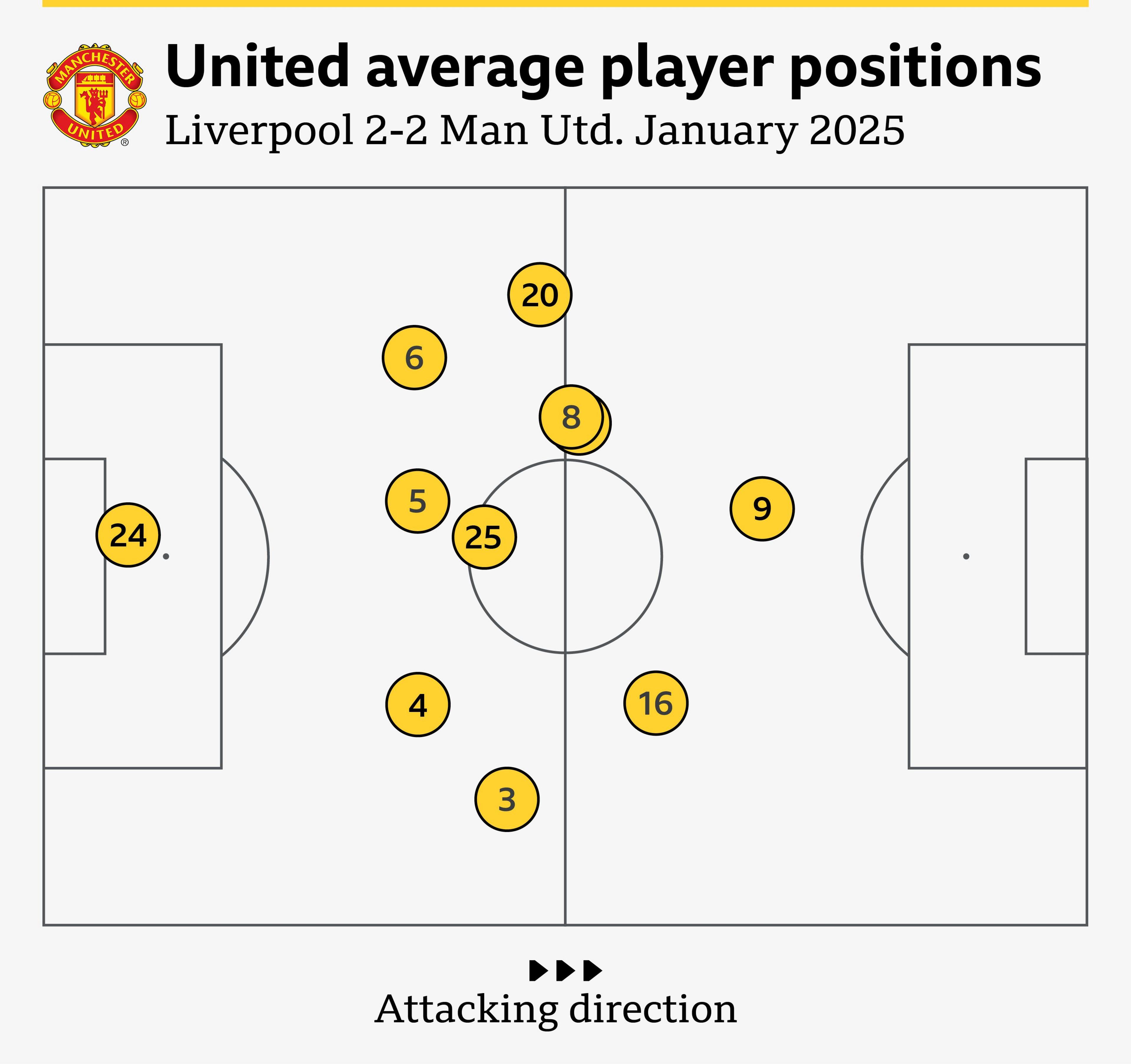
Fernandes' average position (number eight) was in line with - in fact, almost on top of - Mainoo against Liverpool
As with the central defence, there are signs from Anfield that Amorim has begun to fix his midfield problem.
Attack: Diallo leads way as Fernandes role emerges
You wouldn't know it from the first two months, but Amorim prioritises purposeful possession - direct and vertical football played through the thirds when opportunity allows.
But the only player enjoying the style shift right now is Amad Diallo.
Diallo has been directly involved in eight of United's 11 Premier League goals under the new manager (three goals, five assists), and since Amorim's first game in charge only Iliman Ndiaye (25) has completed more dribbles than the Ivorian's 21.
His form had dipped a little since moving from right wing-back to number 10, but yet again the Anfield draw marks a step forward.
Prior to the Liverpool game United had not scored a single open-play goal with Diogo Dalot and Noussair Mazraoui as the two wing-backs, yet on Sunday Dalot was considerably more adventurous as part of Amorim's plan to target Trent Alexander-Arnold.
Dalot had the second-most touches of the ball (70) among United players and took only two fewer than any Liverpool midfielder.
He was one of several players to benefit from a more direct approach, initiated, in part, by Fernandes looking to play long - and often blind - forward passes to get things moving.
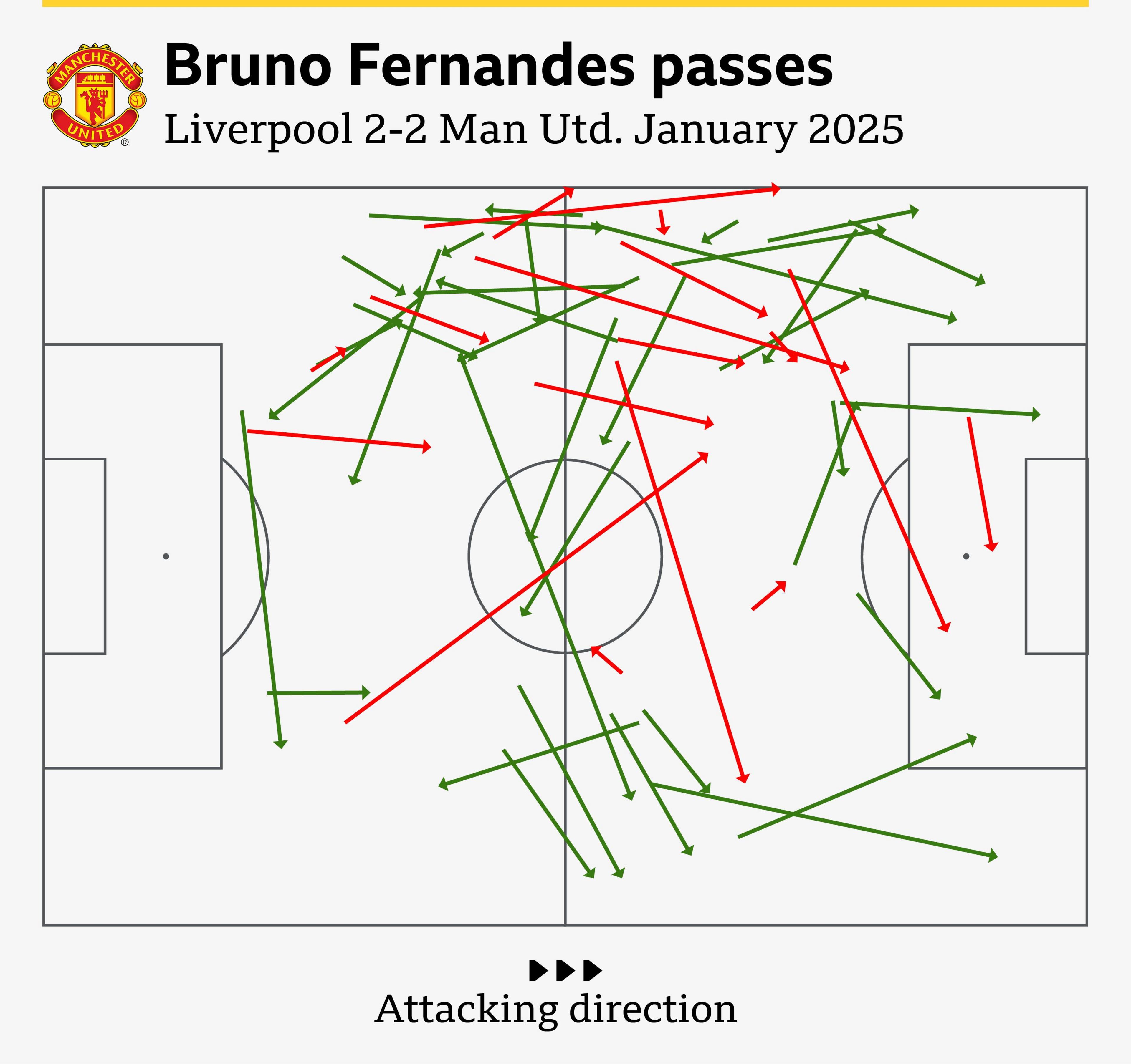
Despite creating 21 Premier League chances since Amorim arrived, the third most in the division, Fernandes has yet to find his feet, regularly moving between the number 10 and central midfield roles.
But against Liverpool Amorim may have found his future role - a hybrid of the two, piercing lines quickly while dropping into midfield to plug the gaps.
Fernandes making sense, the wing-backs pushing forward, Mainoo and Ugarte injecting energy into midfield and the centre-backs forming a partnership - Manchester United's 2-2 draw at Anfield has the potential to be a seminal moment in the Amorim project.
The storm may not be over, but after a messy, formless start to life at Old Trafford we finally have evidence that a hard-pressing, direct and tactically coherent United is possible.
Related topics
- Published26 July 2022

